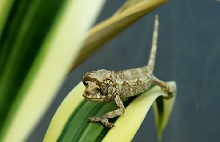Jackson's Chameleon (Trioceros jacksonii)
Description: Jackson's chameleons are sometimes called three-horned chameleons because males possess three brown horns: one on the nose (the rostral horn) and one above each superior orbital ridge above the eyes (preocular horns), somewhat reminiscent of the ceratopsid dinosaur genus Triceratops. The females generally have no horns, or instead have traces of the rostral horn (in the subspecies T. j. jacksoniiand T. j. merumontanus). The coloring is usually bright green, with some individual animals having traces of blue and yellow, but like all chameleons, they change color quickly depending on mood, health, and temperature.
Adult males reach a total length (including tail) of up to 15 inches and females up to 10 inches, but more typical lengths are 6 to 10 inches. It has a saw-tooth shaped dorsal ridge and no gular crest. It attains sexual maturity after five months. The lifespan is variable, with males generally living longer than females.
Habitat: Jackson's chameleons are native to woodlands and forests at altitudes of 5,250 to 8,010 feet in south-central Kenya and northern Tanzania. In these areas, the rainfall is seasonal but exceeds 50 inches per year. Day temperatures are typically 61–81 °F, and night temperatures are typically 39–64 °F.
Range: In Hawaii, they are found mainly at altitudes of 330 to 3,280 feet in wet, shady places. Historically this population was the primary source of Jackson's chameleons for the exotic pet trade in the United States, but exports from Hawaii are now illegal. This has been done to prevent opportunists from willfully establishing further feral animal populations to capture and sell them.
Found in these States:
CA |
HI
Diet: Jackson's chameleons live primarily on a diet of small insects. They also prey on centipedes, isopods, millipedes, spiders, lizards, small birds, and snails in their native habitat.
Reproduction: Most chameleons are oviparous, but Jackson's chameleon are viviparous, giving birth to offspring soon after they are ready to hatch from their egg sac; eight to thirty live young are born after a five to six month gestation. The subspecies T. j. merumontanus gives birth to five to ten live young.
Status: This species is listed as Least Concern due to its large extent of occurrence and tolerance of habitat modification. While it is apparently not heavily impacted by anthropogenic habitat change or by current levels of harvesting across its range as a whole, concerns exist about the sustainability of the scale of exploitation of the Tanzanian subspecies, which may become a significant conservation concern should future research suggest that this warrants recognition as a distinct species.
Subspecies: None found in our region.
»» Kingdom: Animalia - Animals
»» Phylum: Chordata - Chordates
»» Subphylum: Vertebrata - Vertebrates
»» Class: Reptilia - Reptiles
»» Order: Squamata - Lizards
»» Family: Chamaeleonidae - Chameleons
»» Genus: Trioceros
»» Species: Trioceros jacksonii - Jackson's Chameleon
This article uses material from the Wikipedia article "Jackson's Chameleon", which is released under the Creative Commons Attribution-Share-Alike License 3.0. Content may have been omitted from the original, but no content has been changed or extended.
|













